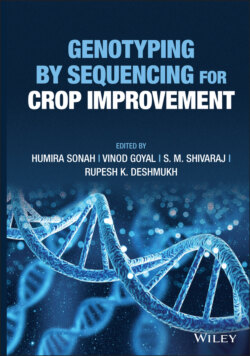Читать книгу Genotyping by Sequencing for Crop Improvement - Группа авторов - Страница 29
1.5.3 SNP Arrays
ОглавлениеAlong with GBS, high‐density DNA array‐based SNP chips or SNP arrays have become a widely used SNP detection platform for high multiplex genotyping. SNP arrays work by hybridization of DNA fragments with allele‐specific oligonucleotide probes (SNP probes) and fluorescence‐based detection of signals. In general, SNP arrays can be roughly categorized into two types based on SNP detection methods: (i) nonenzymatic differential hybridization including allele‐specific hybridization, (ii) enzymatic reactions including primer extension, and mini‐sequencing (Ding and Jin 2009). For making SNP arrays, the first step is the identification of genome‐wide SNPs by sequencing (preferably WGR) of a large diverse panel. The SNPs arrays may include SNPs from coding (genic) regions only and/or genome‐wide SNPs from other noncoding regions. SNPs are in silico validated with several custom tools and final filtered SNPs are identified. The oligonucleotide probes containing SNP alleles are designed and bound on a solid glass plate surface. SNP chips can be custom designed commercially from two widely used platforms: Affymetrics (www.affymetrics.com) as Axiom Affymetrics SNP Chips (Affymetrix/Thermo Fisher Axiom®) or Illumina (https://www.illumina.com/science/technology/microarray.html) as Immunia Infinium assay (Illumina Infinium®). Affymetrics SNP array relies on differential hybridization due to different melting temperatures for matched and mismatched SNPs binding to target DNA sequence. On the other hand, Illumina Infinium assay uses Illumina BeadArray technology that relies on primer extension to distinguish two SNP alleles. The Affymetrix SNP array uses 25‐mer for SNP calling while the Illumina BeadArray uses 50‐mer for target capture. In rice, a high‐resolution 44K Affymetrix array, 50K Infinium array, and 700K high‐density rice array are available for rice SNP genotyping (McCouch et al. 2010; Tung et al. 2010; Chen et al. 2013; McCouch et al. 2015). Additionally, high‐density SNP arrays have been developed for other crop plants such as maize (Ganal et al. 2011) and sunflower (Bachlava et al. 2012) as well as domestic animal species, including cattle (Gibbs et al. 2009; Matukumalli et al. 2009) and pig (Ramos et al. 2009). One major advantage of SNP arrays is the reproducibility of data points where GBS does have some shortcomings. However, the disadvantage is the less polymorphism as compared to GBS and WGR and detection of only alleles present in the array (Table 1.2).
Table 1.2 Comparison between different marker techniques commonly used in plant research.
| SSR | GBS | WGR | SNP array | KASP™ | |
|---|---|---|---|---|---|
| DNA quality | Moderate | High | High | High | High |
| PCR‐based | Yes | Yes | No | No | No |
| Allele detection | High | High | High | Low | Low |
| Polymorphism | High | High | High | Low | Low |
| Ease to use | Easy | Not easy | Not easy | Easy | Easy |
| Reproducibility | High | Low | High | High | High |
| Cost | Moderate | Low to moderate | High | High | moderate |
| Cost for analysis | High | High | High | Low | Low |
| Suitability for different approaches | |||||
| Genetic diversity analysis | High | Moderate | High (cost concerns) | High | High |
| Bi‐parental QTL mapping | High | High | High | High | High |
| Genome wide association analysis | Moderate | High | High | High | Low |
| Genomic selection | Low | Moderate | High (cost concerns) | High | Low |
